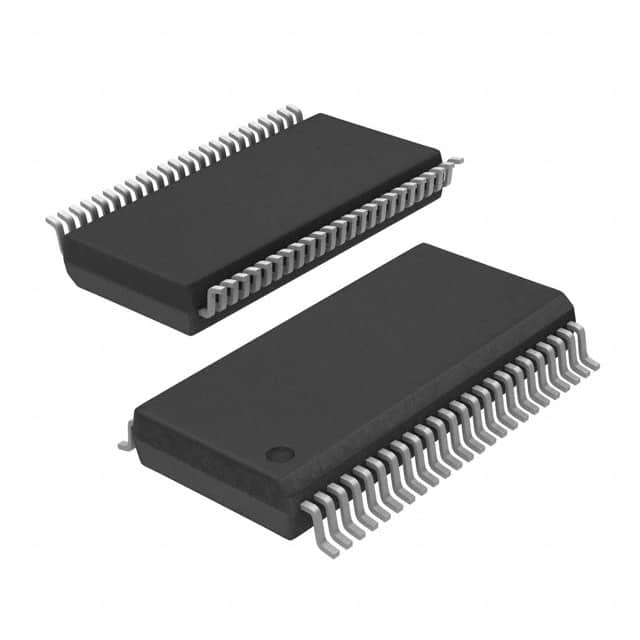Viz Specifikace pro podrobnosti o produktu.

74LVC16244APVG
Basic Information Overview
- Category: Integrated Circuit (IC)
- Use: Buffer/Driver
- Characteristics: Low Voltage CMOS, 16-bit, non-inverting, 3-state
- Package: TSSOP (Thin Shrink Small Outline Package)
- Essence: High-performance buffer/driver for low voltage applications
- Packaging/Quantity: Tape and Reel, 2500 units per reel
Specifications
- Supply Voltage Range: 1.2V to 3.6V
- Input Voltage Range: 0V to VCC
- Output Voltage Range: 0V to VCC
- Maximum Operating Frequency: 80 MHz
- Number of Channels: 16
- Output Current: ±24mA
- Propagation Delay: 4.5ns (typical)
- Operating Temperature Range: -40°C to +85°C
Detailed Pin Configuration
The 74LVC16244APVG has a total of 48 pins arranged in a TSSOP package. The pin configuration is as follows:
_______________________________________
| |
1A1 | 1 48 | VCC
1Y1 | 2 47 | GND
2A1 | 3 46 | 2Y1
2Y1 | 4 45 | 2A2
1A2 | 5 44 | 1Y2
1Y2 | 6 43 | 1A3
2A2 | 7 42 | 2Y2
2Y2 | 8 41 | 2A3
1A3 | 9 40 | 1Y3
1Y3 |10 39 | 1A4
2A3 |11 38 | 2Y3
2Y3 |12 37 | 2A4
1A4 |13 36 | 1Y4
1Y4 |14 35 | 1A5
2A4 |15 34 | 2Y4
2Y4 |16 33 | 2A5
1A5 |17 32 | 1Y5
1Y5 |18 31 | 1A6
2A5 |19 30 | 2Y5
2Y5 |20 29 | 2A6
1A6 |21 28 | 1Y6
1Y6 |22 27 | 1A7
2A6 |23 26 | 2Y6
2Y6 |24 25 | 2A7
|_______________________________________|
Functional Features
- Non-inverting buffer/driver with 3-state outputs
- High-speed operation suitable for low voltage applications
- Wide supply voltage range allows compatibility with various systems
- 3-state outputs provide flexibility in bus-oriented applications
- Low power consumption
Advantages and Disadvantages
Advantages: - High-performance buffer/driver for low voltage applications - Wide supply voltage range allows compatibility with different systems - 3-state outputs provide flexibility in bus-oriented applications - Low power consumption
Disadvantages: - Limited output current capacity (±24mA) - Propagation delay may affect timing-sensitive applications
Working Principles
The 74LVC16244APVG is a non-inverting buffer/driver IC designed for low voltage applications. It takes input signals and amplifies them to drive output loads. The 3-state outputs allow multiple devices to share the same bus, providing flexibility in bus-oriented systems. The IC operates within a wide supply voltage range and consumes low power.
Detailed Application Field Plans
The 74LVC16244APVG can be used in various applications, including: - Data communication systems - Networking equipment - Industrial automation - Automotive electronics - Consumer electronics
Detailed and Complete Alternative Models
Some alternative models that can be considered as alternatives to the 74LVC16244APVG are: - SN74LVC16244A from Texas Instruments - MC74LVC16244A from ON Semiconductor - 74ALVC16244 from NXP Semiconductors - CD74LVC16244A from Texas Instruments
These alternative models offer similar functionality and characteristics, providing options for different design requirements.
Word count: 447 words
Seznam 10 běžných otázek a odpovědí souvisejících s aplikací 74LVC16244APVG v technických řešeních
Sure! Here are 10 common questions and answers related to the application of 74LVC16244APVG in technical solutions:
Q: What is the 74LVC16244APVG? A: The 74LVC16244APVG is a 16-bit buffer/driver with 3-state outputs, commonly used in digital logic applications.
Q: What is the maximum operating voltage for the 74LVC16244APVG? A: The maximum operating voltage for the 74LVC16244APVG is typically 3.6V.
Q: Can the 74LVC16244APVG be used with both TTL and CMOS logic levels? A: Yes, the 74LVC16244APVG is compatible with both TTL and CMOS logic levels.
Q: What is the maximum output current that the 74LVC16244APVG can drive? A: The 74LVC16244APVG can typically drive up to 24mA of output current.
Q: Does the 74LVC16244APVG have built-in protection against overvoltage or short circuits? A: Yes, the 74LVC16244APVG has built-in protection against overvoltage and short circuits.
Q: Can the 74LVC16244APVG be used in bidirectional data transfer applications? A: Yes, the 74LVC16244APVG supports bidirectional data transfer.
Q: What is the propagation delay of the 74LVC16244APVG? A: The propagation delay of the 74LVC16244APVG is typically around 4.5ns.
Q: Can the 74LVC16244APVG be used in high-speed applications? A: Yes, the 74LVC16244APVG is designed for high-speed operation and can be used in such applications.
Q: Does the 74LVC16244APVG have internal pull-up or pull-down resistors? A: No, the 74LVC16244APVG does not have internal pull-up or pull-down resistors.
Q: Can the 74LVC16244APVG be cascaded to drive more than 16 bits of data? A: Yes, multiple 74LVC16244APVG chips can be cascaded together to drive more than 16 bits of data.
Please note that these answers are general and may vary depending on specific datasheet specifications and application requirements.

